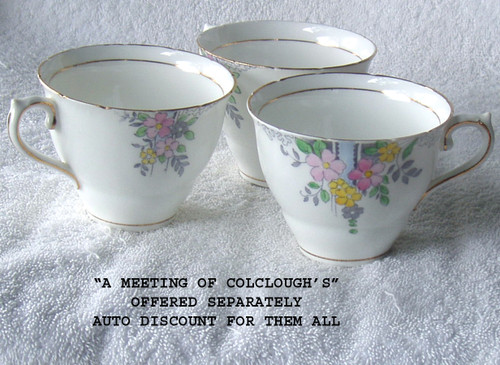Colclough China Ltd was formed in 1937 and operated their works at Longton, Stock-On-Trent called Vale. The use of the name began around this time so these teacups would have been one of the first designs they created.
Colclough China ceased operations in 1996 after having first been acquired by the Ridgeway Group and then subsequently, the Royal Doulton group.
COLCLOUGH CHINA - Teacup ONLY
Circa 1939+ (period positively identified by the backstamp used)
At this time, Colclough would state in their advertising ...
"Britain's largest manufacturer of Bone China Teaware"
It is also worth noting that back in the late 1930's, Colclough was the only pottery offering their products piece by piece, you didn't need to purchase a complete set.
Times were tough back then in the late 1930's and World War II was about to begin ...
Fine Bone China
Translucent china, meaning that when this teacup is held to the light, you can see the shadow of your fingers through the china
Teacup ONLY
Shape: Traditional English one cup with distinctive deep 'dips' along the top rim scalloping
Pattern: name or number is unknown
Design comprises of two groups of 'fantasy' Spring-like flowers, decorated with Gold gilding to the top INSIDE of the cup, the rim, three sides of the handle and the base. I say 'fantasy' flowers because there are colours you would expect such as pink, red and yellow but then there is also Silver Grey flowers!
Definitely hand painted and decorated
Bright white base china
DIMENSIONS:
90mm diameter 'mouth'
70mm height
'Standard' cup handle (not upturned or other fancy variations)
BACKSTAMP DETAILS:
(All of the text below is within a circle)
(Light Grey 'stamped' but under the glaze)
Colclough China
MADE IN
LONGTON ENGLAND
(Following the curve of the circle at the bottom)
GENUINE BONE CHINA
Each teacup has both the artist & gilders marks near the backstamp
COSMETIC CONDITION:
I currently have three of these orphaned teacups, yes, we like to think of ourselves as an orphange of English fine chinaware! Sure we have tons of duo's and trio's but also a lot of orphans who lost their parents years ago (saucer & side plate)
The description below relates to ALL of the teacups, followed by specific points of note relating to a specific teacup ... I have called these teacups A, B and C (pretty sensible huh?)
CLEAN
NO cracks to any teacup
NO crazing observed to any teacup (dry & wet test methods)
NO discolouration to the artwork on any of the teacups
NO wear is apparent to the artwork on any of the teacups
Gold gilding is in very good condition, even on the handle (which is the area most often subject to normal wear n tear) of all cups
NO fleabites observed with any of the teacups
These teacups are the result of human creativity! Imagine this .... almost 85 years old, a young lady sat down and actually created the art on these teacups. I find it amazing to think this while holding the cup in my hand, just as she may have done so many years ago ...
Having that 'human touch' means that imperfections in the decoration will occur, unlike machines we are not perfect (although some may think they are!)
Cup A: a single dot of Light Grey near where the Grey flowers were created
Cup B: a 'wiggly' line near the Light Grey foliage, at first glance you could be forgiven for thinking 'that's a crack!' - it is not ... that's a human at work!
Cup C: a very small, Light Grey dot which is once again very near the Grey foliage
Just for interests sake, I compared the three artist marks but it appears they were all different workers with no two teacups having the same 'artist mark' Actually one artist mark is WITHIN the Colclough backstamp, a big 'no-no' to put you mark over the top of the company employing you ...
I hope my description tells you enough, I enjoy 'how things used to be' and telling my stories!

















